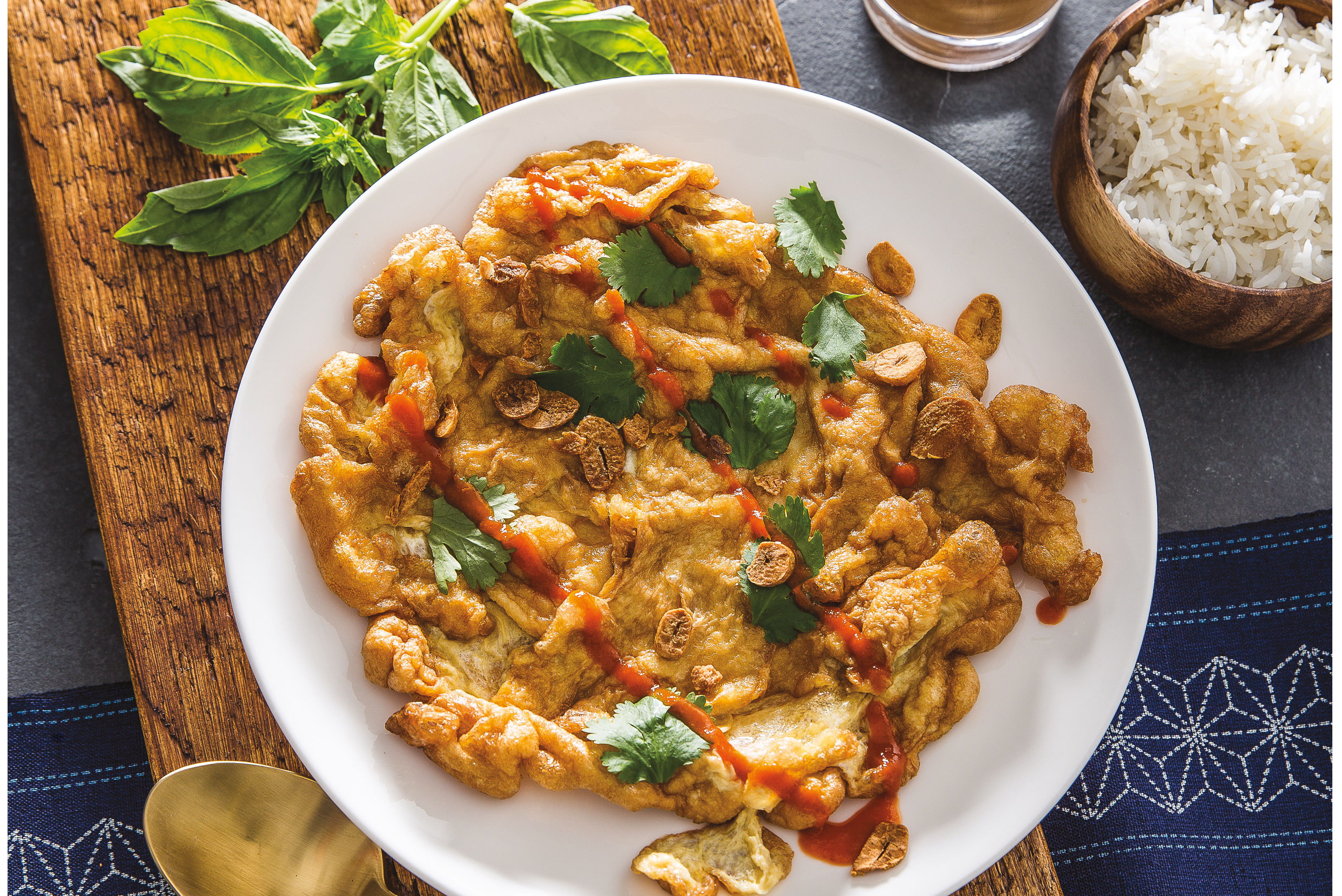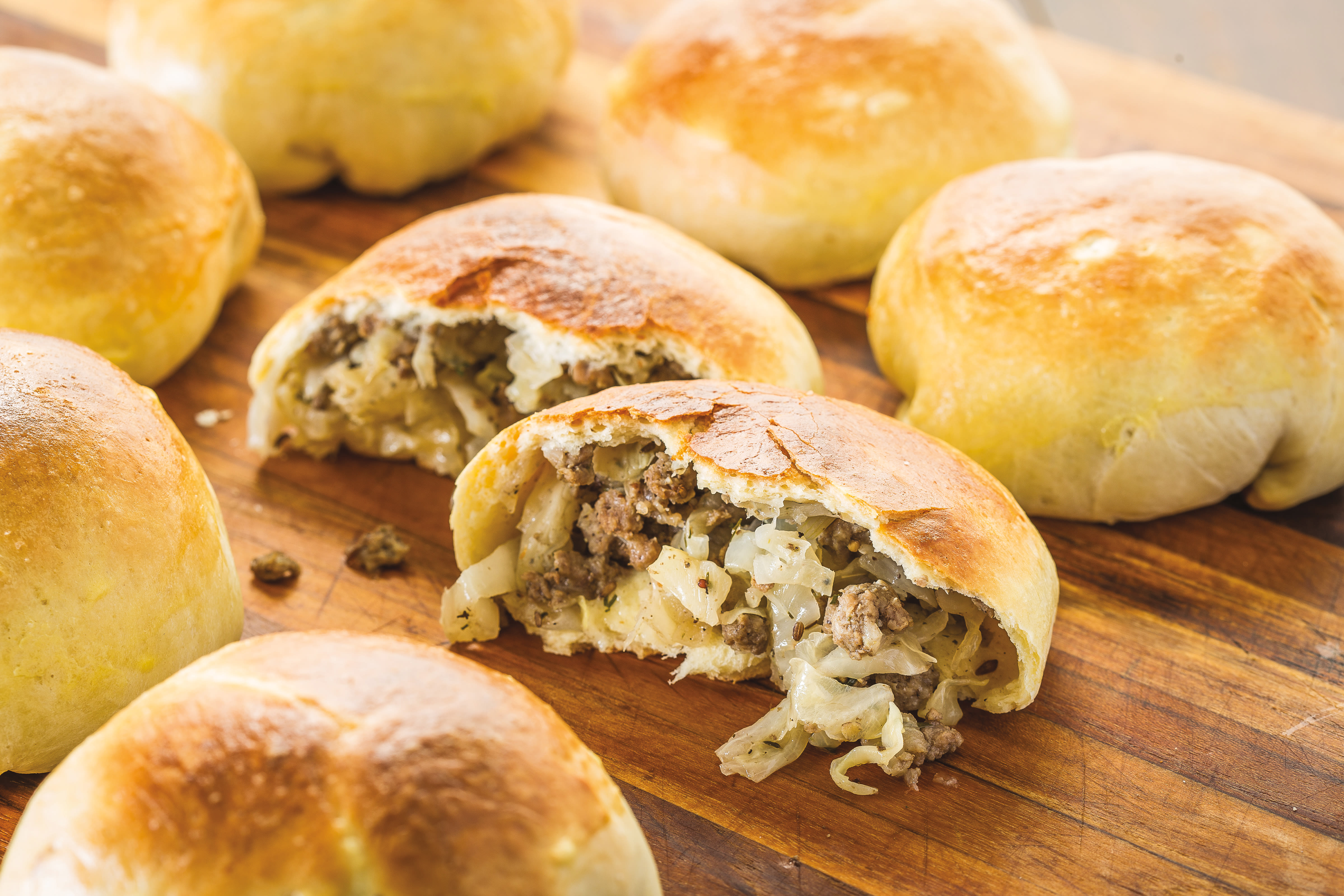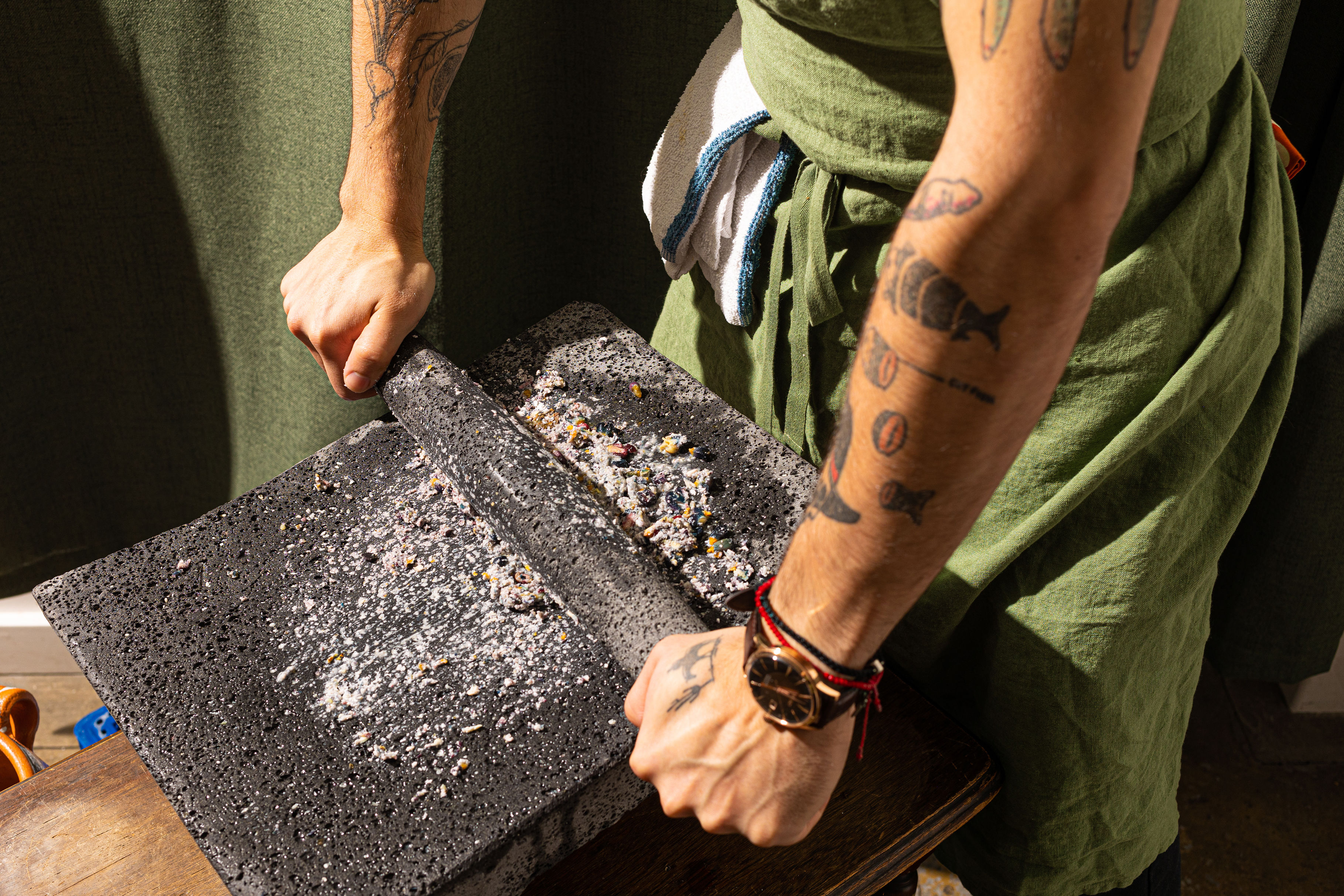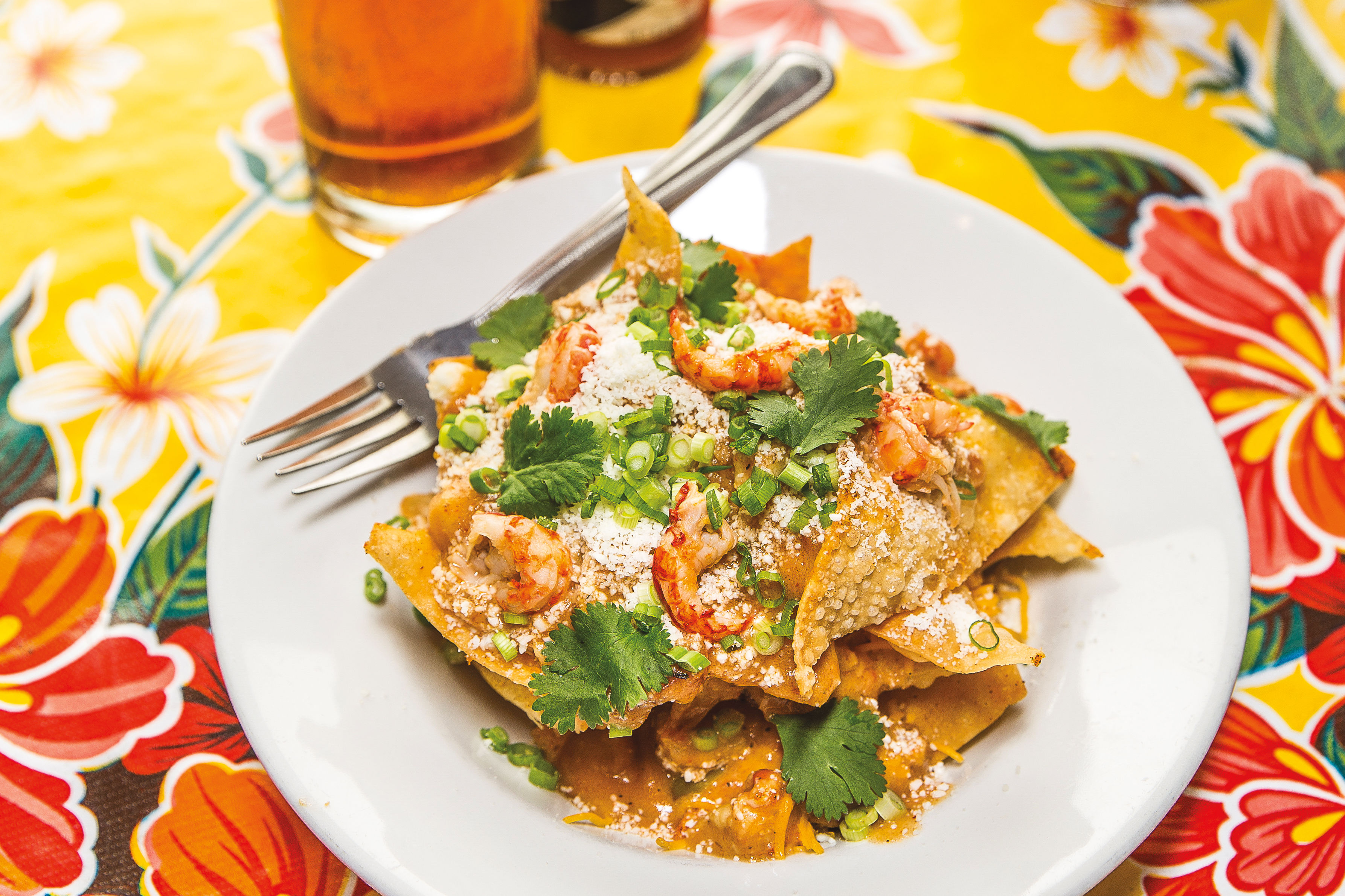
We Asked 20 Portland Chefs and Foodies: What Tastes Like Home?
We set out with a deceptively simple question: What tastes like home? The responses from some of our favorite local chefs and tastemakers rocketed from hearty Haitian soups to pupusas to a formative encounter with dad food. Each person shared where to score these touchstone eats (or how to make them—a Thai-style omelet or Volga German bierocks—at home). This is a snapshot of our ever-expanding food city—and how our sense of home stretches around the globe. Here are their answers, in their own words.
Carlo Lamagna, Twisted Filipino pop-up + Magna (opening spring 2018)
Dish: Kaldareta goat stew
"As a kid, we’d go home to my grandma’s house in the Philippines [most summers]. It was exciting because we’d slaughter a whole goat and make all these dishes from it. And kaldareta was what my Uncle Bill would make. He was the only one that touched that dish. It’s very simple: tomato paste, olives, chickpeas, green peppers, spicy peppers, fish sauce, and goat. And he would use super cheap liver pâté that came in a tin can, like cat food. But once you [took] a bite, you could not stop, you would crave it—it has this nice gamey flavor rounded out by tomato brightness; the liver adds umami richness. My sister would fight people for it. She’d post up right in front of the pot and be there for hours, just eating it.
I don’t know what made it special. Maybe it was starting with a live goat or [how he] stirred the stew over a live fire. He took care with it. I remember sitting in the backyard—not a nice lawn, a dirt yard with a chicken coop and an open kitchen—and helping him with ingredients. I rediscovered kaldareta not too long ago. I made it for a special Filipino dinner at Feast [in 2016]. I was nervous because people [don’t like] goat. I almost used lamb but then I was like, ‘Fuck it,’ and switched back to goat. [Everybody] loved it. Now it’s going on the Magna menu. Uncle Bill passed away three years ago. My memory of him has traveled a long way and every time I eat this dish it sparks the right way." Kaldareta is on the menu at Lamagna’s March Twisted Filipino pop-up dinners, info on Instagram @twistedfilipino
David Gluth, Urban German Grill
Dish: Vollkornbrot
"As a German, I miss bread. There are moments I miss bread more than my family. I grew up in Berlin with ‘real’ bread. Good food takes time. Good bread needs time. I order my buns and pretzels at Fressen, and Edgar Loesch, the baker and owner, became over the years a good friend of mine. He makes the best vollkornbrot [whole-grain bread] you can imagine. It’s dense and hearty, and it tastes great by itself, even with just a little butter. The flavor is really like at home. The dense flavor, the little sourness, the seeds in it—I think Edgar could sell that bread even at home and people would like it." $5, fressenartisanbakery.com
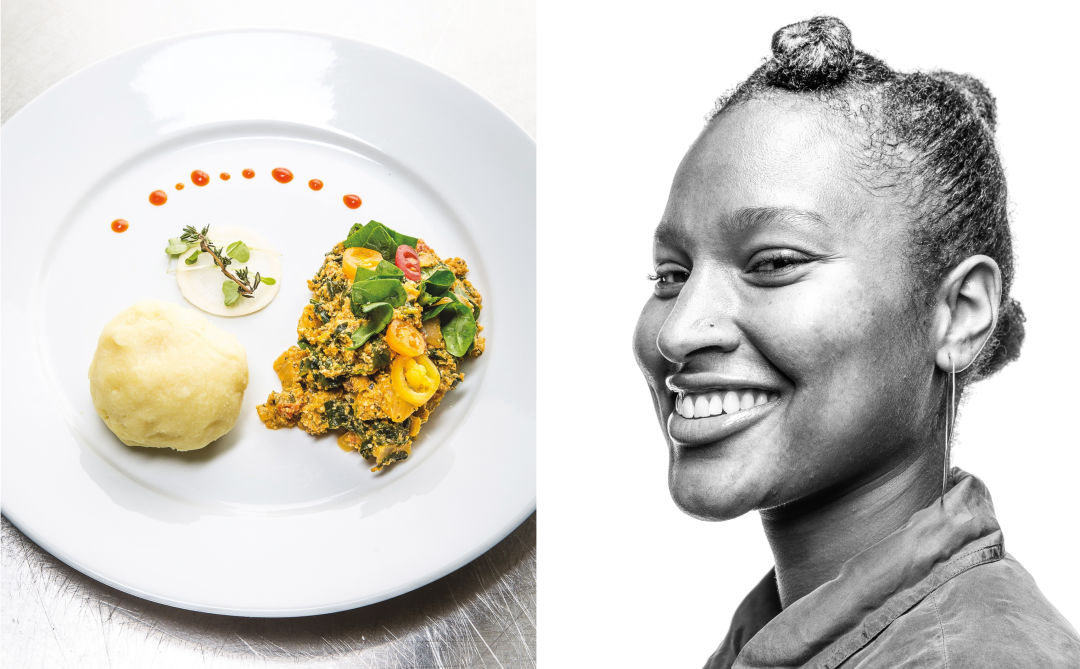
Vegan Nigerian Cuisine egusi with fufu; Salimatu Amabebe
Image: Stuart Mullenberg
Salimatu Amabebe, Bliss House Catering + Vegan Nigerian Cuisine + Black Feast pop-ups
Dish: Egusi
"My dad was from Nigeria (mom’s from Michigan), and egusi is what he cooked all the time. I loved it. It’s a stew made with ground melon seed and fresh spinach or kale, habanero, and bitter leaf (a Nigerian plant). You eat it with fufu, a sticky warm dough that’s made with cocoyam or cassava. When I’d come home from college in New York, he filled probably five Tupperware containers with egusi, taped it all up, and that was my checked luggage. It was so nice to go back to my dorm and be able to eat this amazing stew. I still think my dad made the best egusi.
I grew up in Maine and Arizona, and I’ve spent a lot of time in places that were predominately white, so [as a chef] I think a lot about how I’m expressing this culture, this food that I grew up with. At first, I felt so held to this idea of authenticity and making something traditional, you know? Then I thought about how my dad never used recipes, and my version of authenticity I learned from him.... Now I feel more freedom in it. I take all of those memories and what I’ve learned from my dad and my family, and I put that into each meal. So, I dare someone to call it inauthentic." Egusi is part of many of Amabebe’s $40 four-course Nigerian pop-up dinners, info at facebook.com/blissshouse
Sandro Paolini, Pinolo Gelato
Dishes: Affogato and inzimino
“Affogato was my introduction to drinking coffee as a kid with my grandpa. I’m from Pisa. My grandparents lived outside of Florence, and during the weekend we used to go visit them. My grandfather was born in 1915, and all the old guys from his generation, after lunch they used to go to the coffee bar—it was the social center of the small town of Gambassi. He loved coffee. I would always ask, 'Can I try? Can I try?' He would let me have a spoonful.
The inzimino at Burrasca is the best in town and reminds me of my grandmother. It’s really typical of the Florence area. You can make it with squid or cuttlefish. My grandmother made it with garlic and parsley and just [a few] chile flakes. And oil, a lot of oil. Then some white wine, spinach, and tomato. She loved to cook on the woodstove. In the Italian tradition, you cook really slow and for a long time. The greens become really soft and release a lot of flavor. The cuttlefish or squid has a milder taste, and the consistency can be really buttery. It doesn’t have bones inside, so as a kid it was really easy to eat, really enjoyable, really rich in flavor.” Affogato ($4.95) at Pinolo, pinologelato.com; inzimino ($10) at Burrasca, burrascapdx.com
Lori Kosmas, Mad Greek Deli
Dish: Greek fries
“It’s the story of how I met Pondo Kosmas, and how the Mad Greek Deli became mine. Eleven years ago, my business partner suggested we go there. It was notorious for the good-looking man that worked there. We went to look at the Greek god; it was kind of a joke. I literally tripped through the front door and ordered jojos. He yelled at me and said, 'They’re not jojos, they’re Greek fries!' It was kind of their schtick. The deli has been around since 1977 and [the fries] looked just like jojos you’d get at the grocery store. Everyone always ordered them wrong. A gentleman named Mic would sit at the cash register and start yelling at you: 'We don’t sell jojos, those are Greek fries, we import them from Greece every day!' It became a thing that people came to expect and love.
I wasn’t impressed, but then my business partner mentioned that Pondo had lost his first wife to breast cancer and had fought for custody of her kids. That got me over thinking that he was a jerk; if he was willing to raise three children that weren’t his own, he couldn’t be that bad. He proposed seven weeks after we met, and we became a family of five children. He passed away two years ago, unexpectedly, and I’ve been trying ever since to keep it going and keep his legacy alive. Now that my husband’s gone, [this dish] is the thing that makes me smile—they’re hand-cut, breaded with a special seasoning, deep-fried to the perfect golden brown, with Greek ranch, essentially. (It has a lot of feta; it’s fantastic.) It’s comfort food that makes me feel connected to him. ’Cause it’s the reason that we met in the first place.” $3.25–4.50, madgreekdeli.com
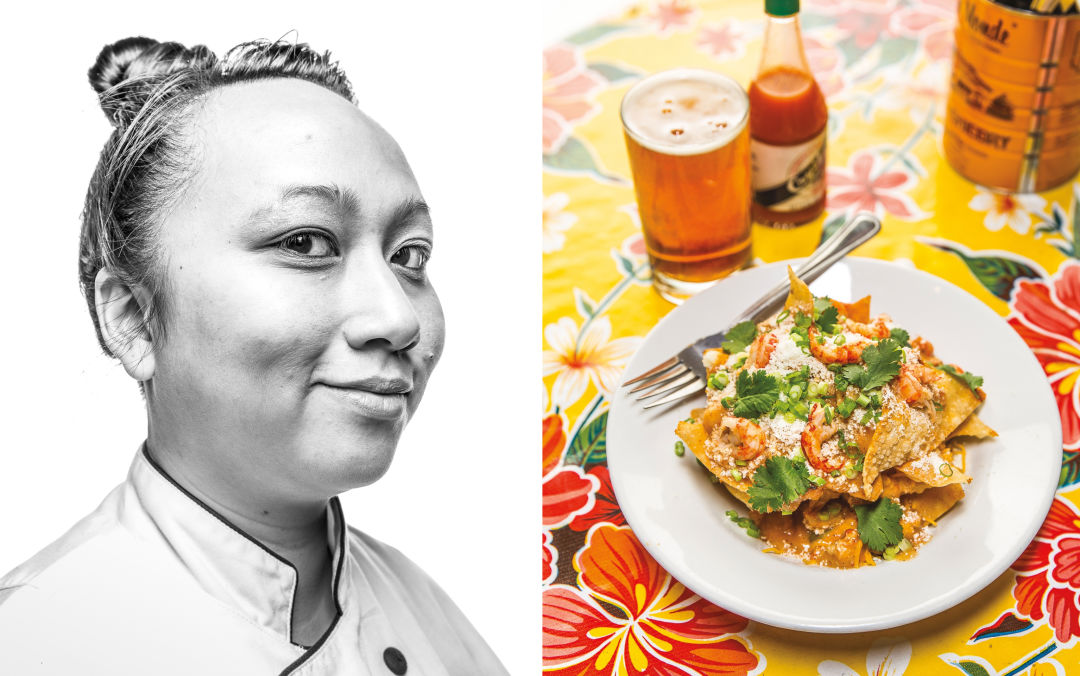
Anh Luu; Tapalaya crawfish étouffée nachos
Image: Stuart Mullenberg
Anh Luu, Tapalaya Cajun/Creole Restaurant
Dish: Crawfish étouffée nachos
“This crawfish étouffée really does symbolize home for me. It makes me feel good about the things I’m cooking right now at Tapalaya. It’s been a really crazy journey. I am the only person raised in America in my immediate family. They were all born in Vietnam. I was born in New Orleans. I’ve been able to reconnect with my Vietnamese roots through cooking. As a child my house was the place everyone would come over and have a cookout with my fisherman uncle’s leftover seafood from his catch and ingredients from mom’s garden. My mom passed away this year. It was really shocking. My memories of my mom are what made me. When my cousins came into town for her funeral, we had a big huge seafood dinner like we used to when I was growing up.
I’ve infused this Cajun dish with all the flavors of my favorite Vietnamese soup, bún riêu (ground-up crab mixed with egg in a soup of tomato broth with lime, lemongrass, and shrimp paste). It’s very shrimpy. For my crawfish étouffée, I put fish sauce in it, and it totally accentuates the shellfish flavor. You can taste the lime and the shrimp paste, too. [Plus] fried chile paste and sambal, but not too spicy—the heat doesn’t come on until after. It has this delicious gravy texture—rice and gravy is such a Southern food staple for me. I serve it with wonton chips, but you can get it with rice too. It’s interesting, when older Vietnamese people or older Louisiana people come into Tapalaya, and they get the étouffée, and they both find it familiar. Both sides can find the same happiness in the dish.” $14 (étouffée served with biscuits at brunch, too), tapalaya.com
Saleshni Sundar, Big Elephant Fijian Kitchen
Dish: Roro (taro leaf in coconut milk)
“If someone asks for the roro I’m like, ‘Oh yeah, you’re from Fiji ... or your parents are from Fiji.’ All Fijians want roro. On the island, taro grows wild everywhere—you get tired of seeing it. But in Portland, taro leaf (the tops, not the root) is very rare. It’s a bit like spinach, but with a lot more flavor and a little sweeter. After you eat taro leaf, you can’t eat spinach anymore. My mom cooks cut up taro leaves with ground ginger and garlic, onions, and fresh red chile peppers. And coconut milk—everything in Fiji has coconut milk. (It’s easier to go in the backyard and grab a coconut off a tree than find a cow to milk. It’s not like in India.)
I’m 24. I own Big Elephant with my brothers—we handle the [business] stuff, mom does the cooking, dad buys the food. The restaurant is my brother’s dream. I’m premed at Portland State. I’ve put that dream on hold to help get our restaurant off the ground. It just happened. My family—with aunts and uncles and cousins—is so huge that my mom is used to cooking with the big pots.
I grew up in Northeast Portland, on Garfield. Eating roro is like being young and coming home from school, and my mom is cooking it up and me and my brothers are sooo excited to eat it. We didn’t get it often. Like any leafy green, you can get this much [spreads her arms wide] but it cooks down to this much [makes a tiny pile with her hands]. You don’t ever get enough of it. Even now, me and my brothers, we’re like: ‘Nope, this is the only thing we’re eating until its gone.’" $7.99, served Wednesdays and Saturdays, check Facebook for updates.
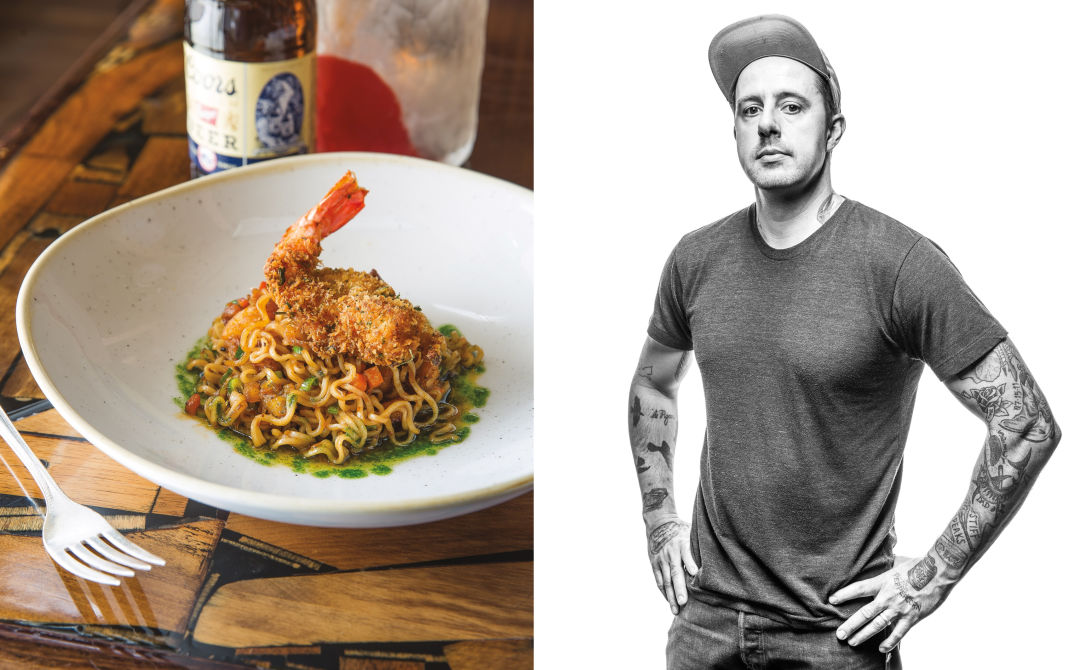
Le Pigeon Total Recall Noodles with Jumbo Prawns; Gabriel Rucker
Image: Stuart Mullenberg
Gabriel Rucker, Le Pigeon
Dish: Total Recall Noodles with Jumbo Prawns
"Growing up in Napa Valley, I didn’t have the idyllic Napa home food culture. That doesn’t mean I didn’t eat well, but it’s wasn’t fancy braised rabbit. Every once in a while, my mom would go off on a teachers conference, and that would leave my dad and me. He’d take me under his wing and show me how a man eats. Sometimes that involved big ribs at the Red Rock Café; other times, greasy cheeseburgers and rings. But one meal stands out: something he made from scratch. I can’t exactly put my finger on it, but I remember he fired up jumbo, breaded prawns and made a sweet, glazed, stir-fried concoction using Top Ramen. At age 9, it was the best thing I’d ever eaten.
Sweet is a big influence at Le Pigeon; just as acid cuts fat, so does sweet. Maybe this is how I discovered my love of sweet with savory? In remembering this story, I’m going to try to re-create this dish for a spring menu. One side note: since mom was out of town, I got to watch Total Recall. This is some hard 1990s right here." Look for Total Recall Noodles for the Le Pigeon menu this March, lepigeon.com.
Tom O’Leary, T.C. O’Leary’s
Dish: The Irish breakfast
“The Irish breakfast does it for me. It’s a perfect antidote to a night out: lots of salt, lots of grease, loads of meat, loads of protein. I call it ‘The Cure.’ From the get-go, Irish breakfast was going to be a part of our pub’s menu. It’s very expensive to import Irish rashers (bacon) so we brine our own, and we make the black and white pudding (blood sausage and oatmeal sausage), too. We even make our own baked beans. Sometimes people will ask for a blaa (a type of bread roll from Southeast Ireland) on the side, too. For me, making the full Irish was a weekend specialty with my mum or my dad. I would be very homesick in Portland, only this pub is my embassy. To be able to have a pint, the paper, the breakfast, and sit in the snug*—it’s just like home." $12, tcolearys.com
*A walled-off portion of a bar traditionally set aside for priests and other private drinkers
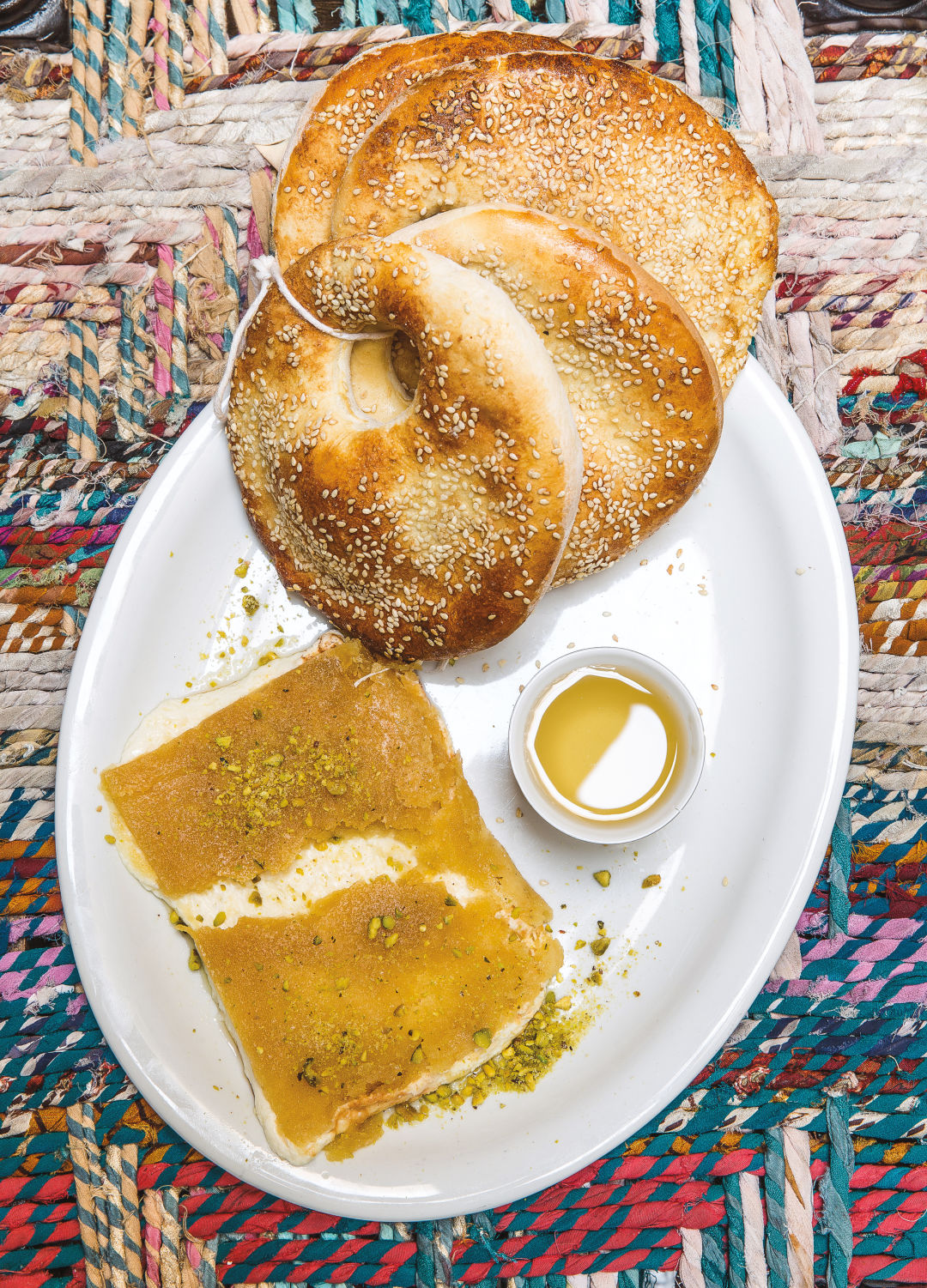
Ya Hala kanefe bejeben
Image: Stuart Mullenberg
Mirna Attar, Ya Hala
Dish: Kanefe bejeben
"We have a sweet breakfast sandwich in Beirut, back home. You find kanefe stacked on food carts in a big circle tray, crusty and red. The fun part is that you eat it inside a sesame pita bun: you put the melted cheese inside the bun, and drizzle with rosewater honey on top. It’s kind of like when you eat doughnuts [in America]. It’s a very Lebanese breakfast staple, for just walking around the streets, or if you have a big group of people you want to feed in the morning. I try to make it the same way they have it in Beirut. And I do a good job of it, too." $7 on Ya Hala’s weekend brunch menu, yahalarestaurant.com
Leena Ezekiel, Thali Supper Club
Dish: Assam-style fried fish
“I grew up in Assam, a remote northeastern state in India known primarily for its tea. But when I’m feeling homesick all I can think about is fish, fish, fish. Given our relative isolation, we had to rely on what was available around us. We ate fish every day for lunch and dinner, and never tired of it. My father woke up early to go to the banks of the Brahmaputra River, which ran through our small town of Jorhat. He was always the first one to buy fish off the boats, often bringing home a whole rahu, which is similar to carp and weighed almost 20 pounds. The fish would be scaled, gutted, and cut into pieces (bones and all), every part cooked in different ways. The head was made into muri ghonto, mixed with lentils; the belly pieces into tenga, a sour tomato-potato stew.
But we most loved the center pieces dusted with cumin, fresh turmeric paste, cayenne, and salt, then shallow-fried in very hot mustard oil. The aroma of the frying fish wafted through the house. My dad snacked on them with his scotch and soda every evening, as we sat around the fireplace, telling stories. I’ve never seen fried rahu in Portland—rahu has big and small bones, and people are not used to bones here. To make my mom’s version, I’ll use something easier for diners to handle, like pompano or rockfish!" Assam-style fried fish is on the menu at Thali Supper Club’s March pop-up dinner, thalisupperclub.com
Jose “Chepe” Cardoza, Chepe’s Pupuseria & Taqueria
Dish: Pupusa
“Our pupusas are from my grandma’s recipe—these are old-time pupusas (masa pockets filled with stretchy cheese and meat). Even in El Salvador they don’t make them anymore the way we do here. As kids we used to get the wood to light up the stove, we’d help her with the masa, boil the corn, all the stuff. It makes me think of home. First of all, I smell it. Then I eat it the way we eat it, by hand—we don’t use forks or anything—with not too much salsa on top because then everything gets wet. There are so many churches, but for El Salvadorans there’s only one religion: it’s the pupusa, no matter what. Come Sunday around two o’clock all the churches are here (at Chepe’s), eating pupusa." $3.50, facebook.com/PupuseriaChepes
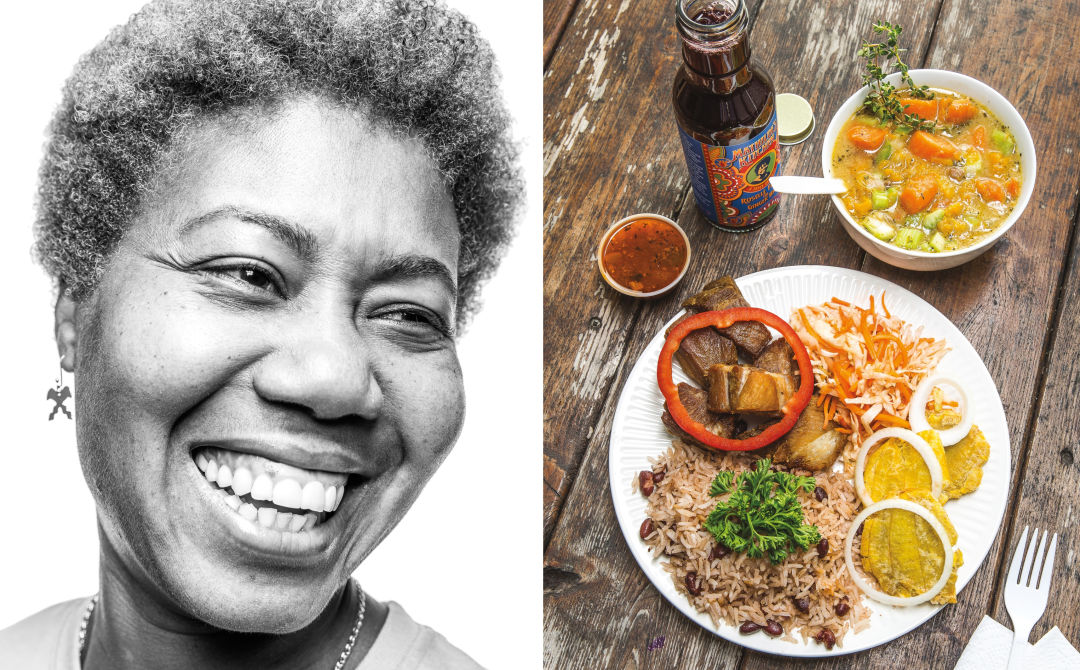
Mathilde Aurélien Wilson; Mathilde’s Kitchen Griot Plate and kongo pea soup
Image: Stuart Mullenberg
Mathilde Aurélien Wilson, Mathilde’s Kitchen Haitian
Dish: Kongo pea soup
"'Cooking with love' is the best description ever of my food because I’m doing it without any training. I grew up in the Southern mountain part of Haiti. As a child, this soup is something we’d make every time we’d grow kongo peas. My family grew most everything we ate: beans, corn, yam, banana. There was no supermarket. [Some had] no access to fertilizers or irrigation, but that pea grows very beautifully no matter how dry it gets. The soup’s flavor is earthy and strong—with thyme and celery, onion and squash, carrot, coconut milk, and fresh garlic. And those peas hold together, they don’t just go mush. (My oxtail is also popular. Some people are like, 'Tail?? I don’t want that!' But it is very good. I marinate the tail overnight in sour orange dip for a unique flavor—I put a little of the habanero-scotch bonnet hot sauce I make on the side too.)
My birth mom was from a poor village, Au Centre Beaumont. I was raised with my dad in another village so I was able to go to school. Years later, I had a little farm and eco-lodge in St. Croix with my husband (he’s American). I’d go back to my birth mom’s village and I’d see people who were the same age as me who never learned how to read or write, they don’t have a roof over their head, they make 9 or 10 kids because they don’t have family planning. Each generation gets poorer and poorer. I thought: A school would make a big difference.
Friends in St. Croix, they loved eating my food. It gave me more confidence in my cooking. So, every Sunday we’d do a fundraiser cookout, sometimes with a band, and more and more people, maybe 100 people, would come and give money. We used the funds to build a school in Au Centre to help 10 kids. But more kids came. We built a bigger one. Today the school more than 100 kids, a lunch program, and a doctor who comes twice a week.
We moved to Portland in 2013, and I started the cart in 2016. At first people asked: What is Haitian food? Now they know. Now, I want to use my cart as a catalyst for awareness for my nonprofit that built the school. And maybe do some more summer cookouts.” $6, menu and updates on Facebook. Info about Wilson’s nonprofit Haiti Community Support at haiticommunitysupport.com. Mathilde’s Kitchen is hosting a $33 pop-up supper as part of Portland Mercado’s March Feastly takeover on Fri, March 23.
Peter Cho, Han Oak
Dish: Taco pizza at Pietro’s Pizza
“Growing up I ate a lot of fast food. Little Caesars, Domino’s ... in high school and college all I ate was fast food. Freakin’ Taco Bell? If it’s not my grandmother’s Korean pork and chive dumplings, or my mom’s whatever ... it’s probably really shitty junky food. Pietro’s Pizza had a taco pizza that my mom absolutely loved. That was like grade-school age. We would get the taco pizza: tortilla chips, shave iceberg, a schmear of beans, salsa ... it was basically like a taco salad on a pizza. I just remember it being really good. My mom loved it. She still talks about it. I think there’s a Pietro’s Pizza that opened in Beaverton, and she talks about wanting to go back with the whole family." $5.80–27.75, pietrosrestaurants.com
Debby Accuardi, Gino's
Dish: Grandma Jean’s pasta sauce
“When Marc and I first opened our Italian restaurant in 1996, we lived upstairs, and every Christmas Eve we would have all the Accuardis in for a potluck—that was about 120 people. And this was the dish: red sauce with pork ribs, stewed beef, and pepperoni (served over penne at Gino’s). The thing was, everyone—every aunt, uncle, and cousin—had their own version, and there would be huge arguments about the right way to make it. It’s all about when the herbs go in, basically. This is a dish that goes generation to generation in our family, back to when Marc’s great-grandparents emigrated from Italy. Now our son Gino, who was 12 when we opened the restaurant, is running the place and living five blocks away. So he’s making it now." $19.75, ginossellwood.com
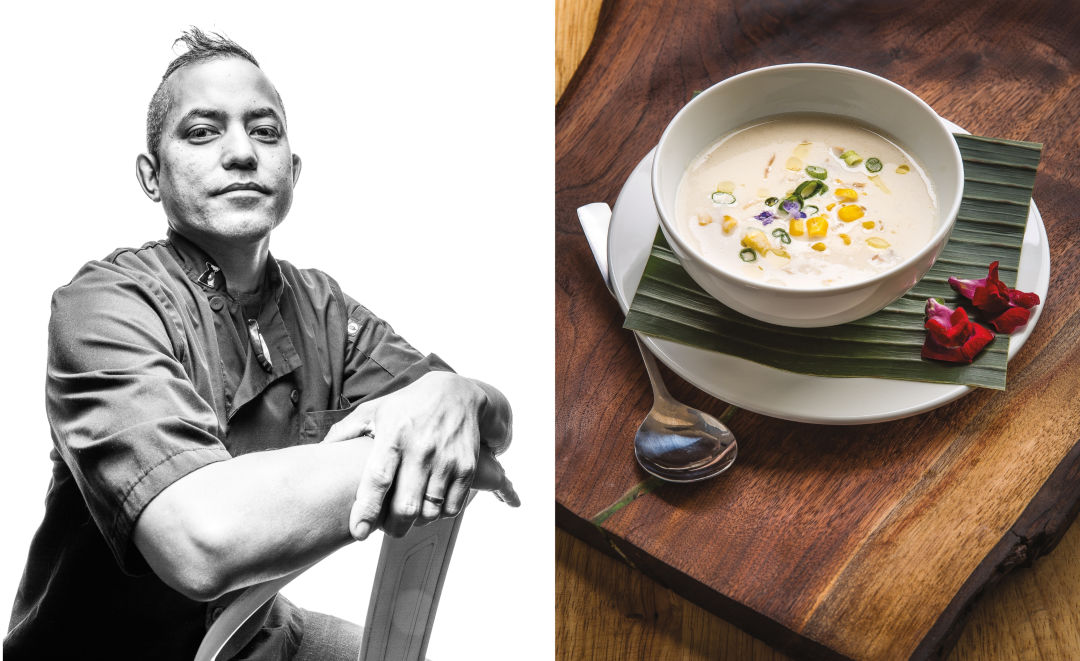
Ed Sablan; PDX671 atulen elotes corn soup
Image: Stuart Mullenberg
Ed Sablan, PDX671 food cart + Food of Guam pop-up
Dish: Atulen elotes corn soup
“Every part of life on Guam, every milestone—births, deaths, weddings—there’s soup. And 9 times out of 10, it’ll be corn soup. I followed my girlfriend to Portland right after high school. (We’re married now—two kids.) But as a kid in Guam, you’re always involved with fiestas, you’re delegated kitchen tasks—you know, “many hands make light work.” It was a culture shock to not be surrounded by all that around here. You don’t get to experience Guam’s indigenous Chamorro cuisine in Portland unless you’re invited to [a native’s] home. So, we opened the cart in 2010. 671 is Guam’s area code.
This is my corn soup, not my mom or dad’s version. It’s comforting, light, and uplifting. And pretty simple: corn, chicken, lemon, good quality coconut milk ... everything else is little accents that I’ve thrown in along the way to refine it. Like caramelized onions. They take forever, like 9 hours on the stove. I get them like they’re almost candy and they do something to the soup that I really like. All the elements are cooked separately, then I add them together in a big hug.
Guam was a trading hub of the Pacific and Chamorro food is a melting pot of influences—Spanish, Asian, and the indigenous culture—with bright citrus flavors, coconut, the smokiness of firewood, and seafood. It’s really hard being proud of your culture and knowing that 50 years from now parts of it may be gone. That the language that we speak might become a dead language. (Older generations speak English and Chamorro, the indigenous language, to us. We spoke mostly English back.) I think: That’s not gonna happen as long as I’m here. There’s been a renaissance, on Guam and elsewhere, of people helping to perpetuate the Chamorro language and culture. Creating well-rounded, flavorful, balanced dishes open the conversation about Chamorro food. Pushing the culture and making sure it lives on, that’s my agenda.” $5, pdx671.com. Sablan hosts a pair of special $33 Portland Dining Month pop-ups dubbed “That’s A Spicy Coconut!” at Feastly on March 13 & 27.
Ian Williams, Deadstock Coffee
Dishes: Buffalo wings & curly fries
“It’s buffalo wings for me. I grew up as a kid in Virginia—I lived there till I was 10—and there was a Rock-Ola rock-and-roll-themed café in Newport News. That’s where we went for birthdays, and with family. The sauce was so perfectly spiced. It reminds me of family dinners. I have an uncle who would put the whole wing in his mouth, then spit out perfectly clean bones. I can’t really find wings here that match them: if you can find Frank’s hot sauce, you can come close. The other thing: seasoned fries at Rally’s, which is the same chain as Checkers. Thick, crispy, soft inside—almost like mashed potatoes. That’s another thing I can’t find in Portland—Jack in the Box is like the closest. I found a Rally’s when I was in California, and I said to my friend, 'We’ve got to go.' And he was like, 'Really?' Yes, man.” $2.99, area Jack in the Box restaurants.
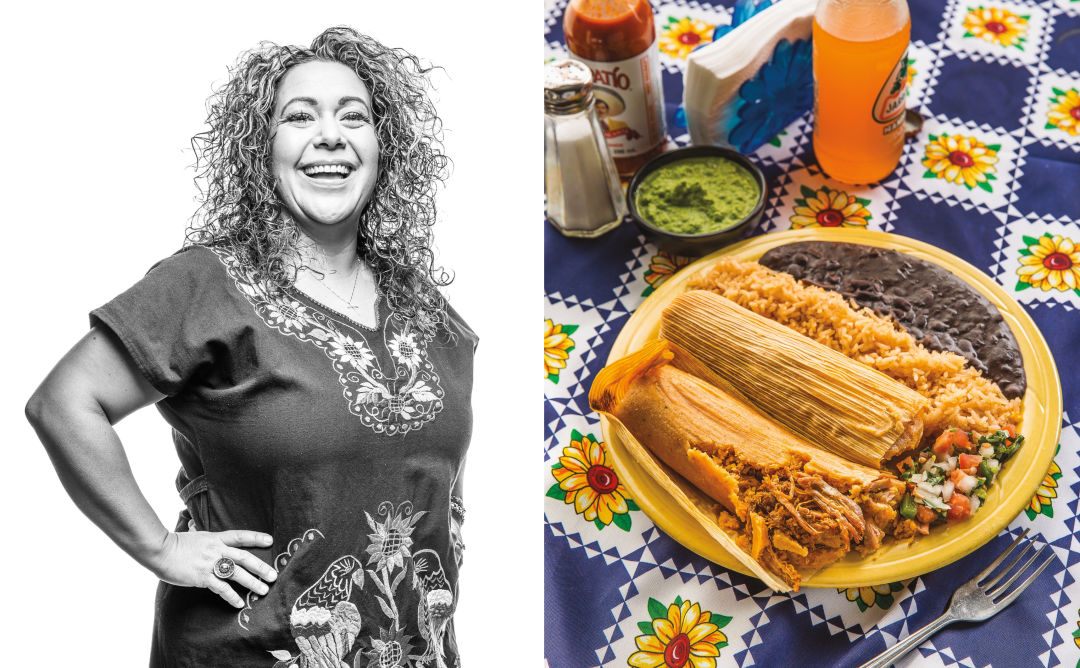
Lucy de Leon; Tortilleria y Tienda de Leon pork tamales
Image: Stuart Mullenberg
Lucy de Leon, Tortilleria y Tienda de Leon
Dish: Pork tamales
“Tamales with pork and red chile sauce take me back to when I was a little girl. My family is from Tamaulipas, just south of Texas on the Gulf of Mexico. I was born in Texas; I’m the youngest of six. We had a house in Texas but we’d be contracted as a whole family to work the fields. We’d go to New York, Minnesota, Illinois, North Dakota, South Dakota. There’d be a lot of men and women that didn’t pack lunch. Mom would get up extra early to make tamales before we’d work, sell them to make extra money for the family. There were times when there wasn’t even a kitchen. I remember in North Dakota, we were sleeping in the car; mom cooked our meals on an open fire right by the field. She always found a way.
We were in Hawaii this last July, and I took mom. We had some chiles with us, but no mortar and pestle. She got a glass cup and began smashing them. And I’m like, 'Jeez, mom, just one little tool, and you can do so many things.' And that’s how it was, growing up. She would make it work—like, 'Don’t complain, we’ll get through this.'
Right now we make so many different kinds of tamales, but pork just brings it all back. We’d always have to jump in and help. It was kind of like a game, to see who could spread the masa faster. December comes around, and we still get together, make ’em. There’s not a wrong way. You have to know how to make your masa. You have to check them [when steaming]. But everyone has their own style. At home, some of my cooks put a whole chicken leg inside; you bite down and you’re like, ‘There’s a bone in here!' But I can’t say that’s wrong.” $9.99 tamale plate, salsaslocas.com
Karlo Prado, Carlito’s Cocina food cart
Dish: Mofongo
“Mofongo [mashed, fried plantains] is the definitive Puerto Rican dish. It always reminds me of my childhood in Puerto Rico, and being in a Puerto Rican kitchen: all the different spices and flavors and just having a lot of family around. Everybody has their own take on how they serve it, passed down from grandmother to mother. In my family, we roast the garlic, then blend it with some olive oil, so it’s not so intense. We fry up the plantains, mash it with a little bit of the roasted garlic sauce (mojo de ajo) and serve as is (some people request mifongo topped with chicharrones). My wife is pregnant with our first child, and I’m really looking forward to cooking my grandmother’s recipes for my little one. Being proud of his Puerto Rican heritage is important, especially in these crazy times.” $8–9, Carlo’s is planning to reopen mid-March in a Lents neighborhood or Beaverton food cart pod. Find updates on Facebook.
Gary Okazaki, a.k.a. “Gary the Foodie,” local power diner
Dish: Domino’s Pizza
“I closed out 2017 like a true 'road warrior,' journeying up and down the West Coast. In just a few weeks, I ate at 40 of the country’s finest restaurants, from the elegance of Seattle’s Canlis to my favorite restaurant in America, the three Michelin-starred Manresa in Los Gatos. This wasn’t a one-off; I sometimes [eat] four dinners in an evening.
[But] when I got home recently, I went to my computer and typed the letters that make me very happy: 'd-o-m-i-n-o-s.' Yep, Domino’s Pizza. I don’t crave iconic, world-famous dishes. Actually, there’re few things in this world I crave. But Domino’s is different. I have a real a love for it. I grew up on a Portland farm, so we didn’t eat fast food. I don’t know exactly when Domino’s took hold in my life, but I’ve ordered the same home delivery pizzas, almost exactly once a month, for roughly 15 years. I always get one pepperoni/black olives and one Italian sausage/mushrooms, medium size and thin crust. I eat them right out of the box. They’re just as good—or even better!—when cold the next day. There’s something about cold Domino’s pizza … it’s a different experience than eating it hot. I’ve tried other variations, but it’s not the same; none are as compelling. No words can truly describe why I must have these two particular combos. Why does a pregnant woman crave ice cream? There’s nothing special about the ingredients, but put together, they become more than sum of their parts. Sometimes two plus two equals five.” $14.75 plus delivery charges, pizza.dominos.com/oregon/portland




